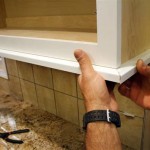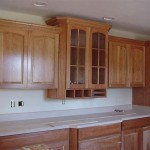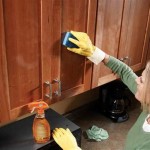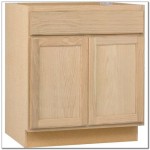Kitchen Cabinet Color Ideas With Butcher Block Countertops
Butcher block countertops offer warmth, durability, and a touch of rustic charm to any kitchen. Their natural wood grain and inviting textures complement a wide array of cabinet colors, creating kitchens that are both functional and aesthetically pleasing. Selecting the ideal cabinet color to pair with butcher block is a crucial decision that can significantly impact the overall look and feel of the space. This article explores various cabinet color options that harmonize effectively with butcher block countertops, providing inspiration for creating a kitchen that reflects personal style and enhances the home's value.
The inherent warmth of butcher block countertops arises from the diverse tones present within the wood itself. Depending on the type of wood used, butcher block can range from light, creamy tones to deep, rich browns. This natural variation allows for a multitude of cabinet color pairings, from classic neutrals to bold, statement hues. The key is to understand the undertones of the butcher block and choose cabinet colors that either complement or contrast in a visually appealing way.
Consider the overall lighting conditions within the kitchen space when selecting cabinet colors. Natural light will accentuate the warmth of the butcher block and can make certain cabinet colors appear brighter. Conversely, in kitchens with limited natural light, lighter cabinet colors can help to brighten the space and prevent it from feeling dark or closed-in. Artificial lighting also plays a significant role, and the type of light bulbs used (warm or cool) can affect how the cabinet colors and butcher block appear.
Neutral Cabinet Colors: A Timeless Choice
Neutral cabinet colors offer a versatile and enduring option for kitchens with butcher block countertops. These colors provide a calming backdrop that allows the natural beauty of the butcher block to shine. White, off-white, gray, and beige are all excellent choices within the neutral spectrum.
White cabinets create a clean and classic aesthetic. They offer exceptional brightness and reflect light, making them ideal for smaller kitchens or those with limited natural light. White cabinets paired with butcher block offer a stark contrast that highlights the wood's grain and warmth. Different shades of white, such as antique white or creamy white, can subtly alter the overall look, adding depth and dimension to the kitchen.
Off-white cabinets offer a softer alternative to stark white. These colors often have slightly warmer undertones, which harmonize beautifully with the warmth of butcher block. Off-white cabinets create a cozy and inviting atmosphere, making them a popular choice for farmhouse-style kitchens or those seeking a more relaxed feel.
Gray cabinets have become increasingly popular in recent years due to their versatility and modern appeal. Gray can range from light, airy shades to deep, dramatic tones. Light gray cabinets offer a similar brightness to white cabinets but with a more subtle and sophisticated feel. Dark gray cabinets, on the other hand, create a striking contrast with the butcher block, adding depth and visual interest to the kitchen.
Beige cabinets provide a warm and inviting neutral option. These colors often have earthy undertones that complement the natural tones of butcher block. Beige cabinets create a sense of warmth and comfort, making them a suitable choice for kitchens seeking a rustic or traditional feel. They pair particularly well with butcher block countertops that feature warmer wood tones.
Bold Cabinet Colors: Making a Statement
For those seeking a more dramatic and personalized kitchen design, bold cabinet colors can be an excellent choice. These colors can add character and personality to the space, creating a focal point that draws the eye and reflects individual style. Blue, green, red, and black are all popular bold cabinet colors that can be paired effectively with butcher block countertops.
Blue cabinets offer a range of options, from light and airy coastal blues to deep and sophisticated navy blues. Light blue cabinets create a calming and refreshing atmosphere, while navy blue cabinets add a touch of drama and elegance. Blue cabinets pair particularly well with butcher block countertops that have lighter wood tones, creating a balanced and visually appealing contrast.
Green cabinets evoke a sense of nature and tranquility. Light green cabinets create a fresh and airy feel, while darker greens, such as forest green or olive green, add depth and sophistication. Green cabinets complement the natural warmth of butcher block, creating a harmonious and inviting kitchen space. Consider the surrounding elements within the kitchen, such as wall color and backsplash, to ensure the green cabinets blend seamlessly with the overall design.
Red cabinets are a bold and daring choice that can add energy and excitement to the kitchen. Red cabinets are best suited for larger kitchens or those with ample natural light, as they can be overwhelming in smaller spaces. When paired with butcher block, red cabinets create a striking contrast that draws attention and makes a statement. To balance the boldness of red cabinets, consider using lighter-colored hardware and accents.
Black cabinets offer a sleek and modern aesthetic. Black cabinets create a dramatic contrast with butcher block, highlighting the wood's natural grain and warmth. Black cabinets are best suited for larger kitchens with ample natural light, as they can make smaller spaces feel closed-in. To prevent black cabinets from feeling too stark, consider incorporating lighter-colored elements, such as a white backsplash or stainless steel appliances.
Considerations for Undertones and Wood Species
When selecting cabinet colors to pair with butcher block countertops, it is essential to consider the undertones of both the cabinets and the wood. Undertones are subtle hues that lie beneath the surface color and can significantly impact how colors interact with each other. Identifying the undertones of both the cabinets and the butcher block will help to create a cohesive and harmonious kitchen design.
Warm undertones, such as yellow, orange, and red, tend to create a cozy and inviting atmosphere. Warm undertones are often found in wood species like cherry, maple, and walnut. Cabinets with warm undertones, such as creamy whites or earthy beiges, will complement butcher block countertops with warm undertones, creating a cohesive and harmonious look.
Cool undertones, such as blue, green, and purple, tend to create a more modern and sophisticated atmosphere. Cool undertones are often found in wood species like oak and ash. Cabinets with cool undertones, such as light grays or soft blues, will complement butcher block countertops with cool undertones, creating a balanced and refined space.
The choice of wood species for the butcher block countertop also plays a significant role in determining the ideal cabinet color. Different wood species have varying grain patterns and color variations, which can impact the overall look and feel of the kitchen. Understanding the characteristics of different wood species will help to choose cabinet colors that enhance the beauty of the butcher block and create a cohesive design.
Maple butcher block offers a light and clean aesthetic. Its fine grain pattern and creamy color make it a versatile choice that pairs well with a wide range of cabinet colors, from crisp whites to bold blues and greens. Maple butcher block is a durable and affordable option that is suitable for both traditional and modern kitchens.
Oak butcher block features a more pronounced grain pattern and a warm, golden color. Its rustic and durable nature makes it a popular choice for farmhouse-style kitchens. Oak butcher block pairs well with neutral cabinet colors, such as off-whites, beiges, and grays, as well as bolder colors like navy blue and forest green.
Walnut butcher block offers a rich and luxurious aesthetic. Its dark brown color and intricate grain pattern make it a statement piece that adds elegance to any kitchen. Walnut butcher block pairs well with lighter cabinet colors, such as whites, creams, and light grays, as well as bolder colors like black and deep reds. Its inherent richness provides a grounding element, making it suitable for an array of design aesthetics.
Ultimately, the best cabinet color to pair with butcher block countertops depends on personal preference and the overall design aesthetic of the kitchen. By considering the undertones of the cabinets and the wood, the lighting conditions within the space, and the desired mood, one can create a kitchen that is both beautiful and functional. Experimentation with color palettes and combinations is encouraged to discover the perfect pairing that reflects individual taste and enhances the home's value.
:max_bytes(150000):strip_icc()/Simple-modern-shiplap-kithcen-black-59949b62aad52b0011676e5d.jpg?strip=all)
16 Modern Kitchens With Butcher Block Countertops

Kitchens With Butcher Block Counters Gofoodservice

Changing The Plans Butcher Block Countertop Inspiration Life With Lavery

19 Inspiring Kitchens With Butcher Block Countertops Coco Lapine Designcoco Design

20 Beautiful Kitchens With Butcher Block Countertops

19 Inspiring Kitchens With Butcher Block Countertops Coco Lapine Designcoco Design

Kitchens With Butcher Block Counters Gofoodservice

25 Butcher Block Countertops For Your Kitchen Shelterness

36 Butcher Block Island Ideas From Rustic To Modern

71 Cozy Wooden Kitchen Countertop Designs Digsdigs
Related Posts








